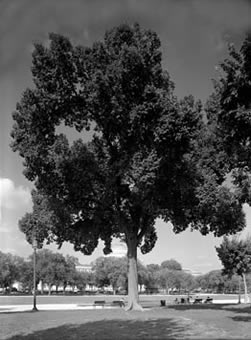
Washington, D.C.
Elms of the National Mall
Courtesy National Park Service
History (Jefferson American Elm)
Commonly known as the American elm (and also known as the white elm, water elm, soft elm, swamp elm, and Florida elm), Ulmus americana is one of about eighteen species within the genus Ulmus. It has an extremely fast growth rate, often adding three feet or more of vertical growth in a single year. Most trees reach heights of sixty to eighty feet, but some individuals have grown to one hundred forty feet. Research indicates that the American elm may reproduce late into maturity, with trees as old as 300 years reportedly bearing seeds. The Jefferson American Elm, planted circa 1935, is now over seventy years old. With an expected natural longevity of at least 150 years, the tree is physiologically mature but not chronologically old. Today, the tree stands approximately 55 feet tall and has a girth of 37 inches at breast height.
Since its introduction from Europe into the United States in 1928, Dutch elm disease has devastated the country’s American elms. The disease is caused by three different types of fungi and is spread by the European elm bark beetle and the Native elm bark beetle. An infected American elmresponds by blocking its vascular cambium in order to prevent the fungus from spreading further. However, this plug prevents the cambium from delivering water and nutrients throughout the tree, and the diseased elm eventually dies. The process is often slow, beginning with the withering and dieback of upper branches, and may take several years to completely kill a tree. While it is possible to manage the disease, it is costly and time consuming and, therefore, unavailable to most municipalities. Consequently, the disease has destroyed many of the grand specimens planted in the 18th and 19th centuries, and killed off scores of younger trees well before they reached 150 years of age. Because of the widespread popularity of the American elm in landscape design, the death of several million trees has had an extremely deleterious effect on neighborhoods across America.